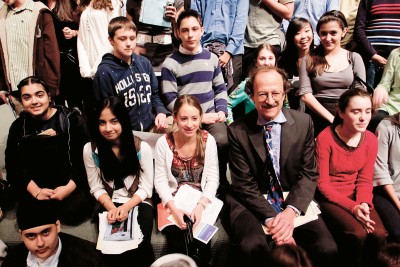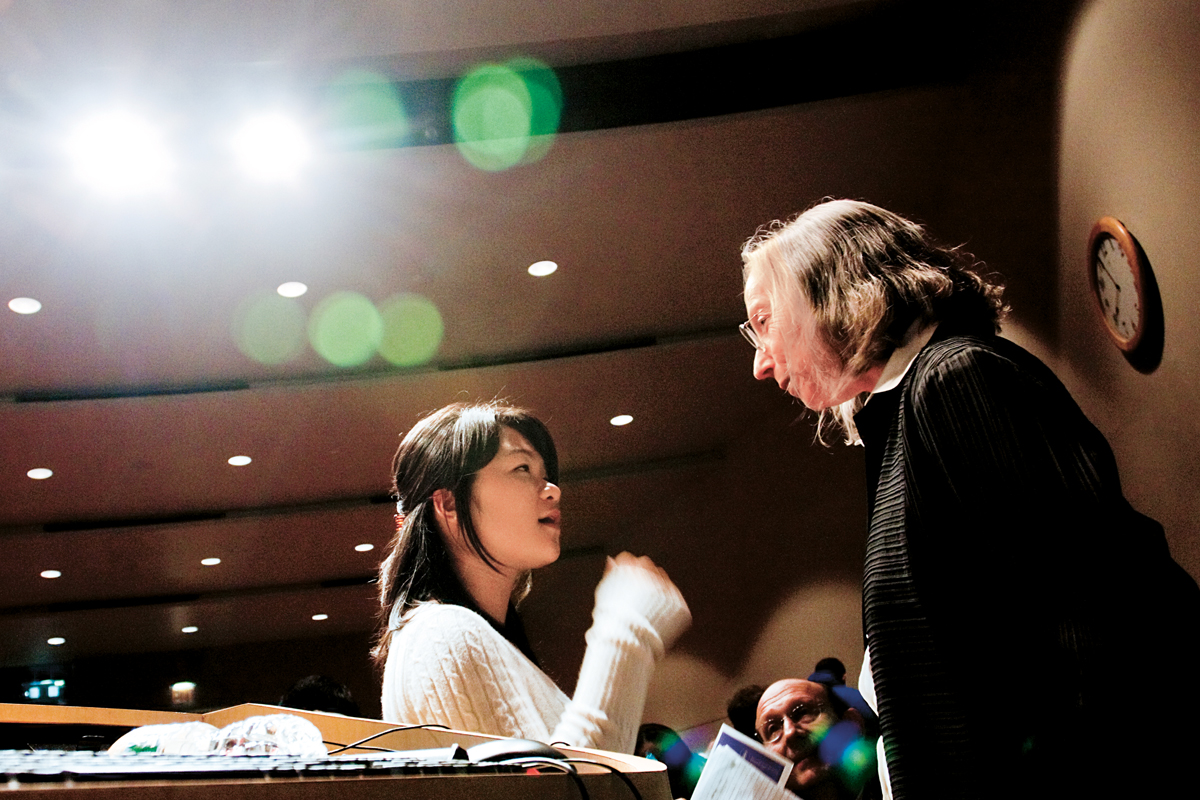
Students pose with Memorial Sloan Kettering President Harold Varmus after the symposium.
An important part of Memorial Sloan Kettering’s mission has always been education. As part of that goal, an annual symposium called Major Trends in Modern Cancer Research was created to expose members of the public, especially high school students and their teachers, to cutting-edge research that is having a major impact on improving the understanding of cancer.
The third annual Major Trends in Modern Cancer Research symposium was held in late 2008 in Memorial Sloan Kettering’s Rockefeller Research Laboratories Auditorium. Approximately 460 students from about 60 schools in the New York City area attended the event, many with their teachers.
“I want to say a word or two about what we’re trying to achieve this evening,” said Memorial Sloan Kettering President Harold Varmus in welcoming the audience. “We can’t, of course, possibly give you a full repertoire of all the things that are going on in the world of cancer research, but we would like to illustrate some of the trends by giving you snapshots of what is going on in very large domains of cancer research.”
Tom Keenan, who teaches biology, chemistry, and physics at Hunter College High School brought about half a dozen students to the symposium for the second year in a row. “My students love this lecture series,” he said. “They feel privileged to be among the first people to hear about the cutting-edge research at Memorial Sloan Kettering, and also enjoy that the material is presented in a fashion that is accessible to anyone.”

Developmental Biology Program Chair Kathryn Anderson speaks with a student the symposium.
The symposium’s three speakers focused on their individual areas of research and put that research into a larger context, explaining how the understanding of certain genes or cellular or developmental processes contributes to a larger understanding of what goes awry in the body when cancer forms.
Kathryn V. Anderson, Chair of the Developmental Biology Program in the Sloan Kettering Institute, talked about the study of developmental biology and its relationship to cancer, noting that cancers arise within certain types of tissue in the body, such as lung tissue or colon tissue. “When you think about tumor genesis,” she explained, “you really have to remember that tumors are arising in tissues. Developmental biologists think about tissues in the context of development, and it turns out that the molecules that are important in development are actually crucial for the development of tumors.”
Developmental biology is the study of how a single cell develops into an entire organism and the molecular signals that direct cells to differentiate, or take on a more specialized form. Throughout her research career, Dr. Anderson has studied these processes in two model organisms, the Drosophila fruit fly and the mouse. Much of her recent work has focused on a signaling molecule in mice called Sonic hedgehog, creating mice with mutated versions of that molecule and studying how the mutations influence brain development. This research has shed light on the understanding of a type of pediatric brain cancer called medulloblastoma.

Molecular biologist Prasad Jallepalli shares details of his research after the symposium.
Prasad V. Jallepalli, a member of SKI’s Molecular Biology Program, spoke about his work studying how cells divide. “A really fundamental question is trying to understand these sorts of processes and how they tie into human biology,” he said. “I hope I’ll be able to convince you that these underlying processes are not just simply the nuts and bolts of cell division but … when corrupted give rise to diseases, including cancer.”
Dr. Jallepalli’s laboratory focuses on what happens inside the cell before it divides: how it duplicates its contents, especially its genetic material, and how the cell determines where to divide. If cells divide improperly, new daughter cells may have extra copies or too few copies of chromosomes, which can lead to genomic instability and to cancer. In particular, his research has centered on something called the spindle checkpoint, which is the surveillance system inside the cell that ensures that chromosomes line up and separate correctly during cell division.
Kenneth Offit, Chief of the Clinical Genetics Service in Memorial Hospital, discussed the role that inherited genes play in the development of many types of cancer, including cancers of the breast, ovary, prostate, and colon. He was part of the team that discovered the most common mutation in the gene BRCA2, which confers a 20- to 50-fold increased risk of breast cancer and ovarian cancer. As a member of the Clinical Genetics Service, he works with patients who may have an increased risk of certain cancers because of family or personal history.

Geneticist Kenneth Offit spoke about the role of inherited genes in the development of cancer.
“As we study cancers as they progress from normal tissue to small preinvasive and premalignant tissues to tumors to metastatic tumors, we know that these genetic mutations occur all along the way in this pathway,” Dr. Offit explained. “But the question here is, What about this first mutation? How many individuals are born with an inherited mutation in all of the cells in their body that leads to a predisposition to cancer?” He went on to discuss ongoing research in his laboratory and others that is using new technology to identify additional genes associated with an increased risk of cancer.
“Anyone curious about cancer and disease would find these lectures extremely enlightening,” Mr. Keenan added. “Everyone is curious to know how cancer therapies will advance in the years to come.



